Physicochemical Properties and Environmental Effects of Suspended Sediment Particles in the Largest Freshwater Lake, China
Abstract
:1. Introduction
2. Materials and Methods
2.1. Study Area
2.2. Collect Samples
2.3. Data Processing Method
3. Results and Discussion
3.1. Physical Properties of Suspended Sediment Particles
3.2. Chemical Characteristics of Suspended Sediment Particles
3.3. Drive Mechanism for Differences in Physicochemical Properties
3.4. Physico-Chemical Properties Differences Trigger Environmental Effects
4. Conclusions
Supplementary Materials
Author Contributions
Funding
Institutional Review Board Statement
Informed Consent Statement
Data Availability Statement
Acknowledgments
Conflicts of Interest
References
- Borthakur, A.; Wang, M.; He, M.; Ascencio, K.; Blotevogel, J.; Adamson, D.T.; Mahendra, S.; Mohanty, S.K. Perfluoroalkyl acids on suspended particles: Significant transport pathways in surface runoff, surface waters, and subsurface soils. J. Hazard. Mater. 2021, 417, 126159. [Google Scholar] [CrossRef] [PubMed]
- Liu, M.Y.; Huai, W.X.; Chen, B. Predicting the effective diffusivity across the sediment-water interface in rivers. J. Clean. Prod. 2021, 292, 126085. [Google Scholar] [CrossRef]
- Zhao, Y.; Zou, L.; Niu, Z.; Luo, X.; Li, X. Advances in the Analysis of Organic Contaminants in Sediments and Particu-late Matters by Liquid Chromatography-High Resolution Mass Spectrometry. J. Instrum. Anal. 2021, 40, 1396–1408. [Google Scholar]
- Adhikari, P.L.; Maiti, K.; Bam, W. Fate of particle-bound polycyclic aromatic hydrocarbons in the river-influenced continental margin of the northern Gulf of Mexico. Mar. Pollut. Bull. 2019, 141, 350–362. [Google Scholar] [CrossRef] [PubMed]
- Chen, C.; Kong, M.; Wang, Y.Y.; Shen, Q.S.; Zhong, J.C.; Fan, C.X. Dredging method effects on sediment resuspension and nutrient release across the sediment-water interface in Lake Taihu, China. Environ. Sci. Pollut. Res. 2020, 27, 25861–25869. [Google Scholar] [CrossRef] [PubMed]
- Fan, J.Y.; Jian, X.; Shang, F.; Zhang, W.; Zhang, S.; Fu, H.J. Underestimated heavy metal pollution of the Minjiang River, SE China: Evidence from spatial and seasonal monitoring of suspended-load sediments. Sci. Total Environ. 2021, 760, 142586. [Google Scholar] [CrossRef]
- Drummond, J.; Schmadel, N.; Kelleher, C.; Packman, A.; Ward, A. Improving Predictions of Fine Particle Immobilization in Streams. Geophys. Res. Lett. 2019, 46, 13853–13861. [Google Scholar] [CrossRef]
- Walch, H.; von der Kammer, F.; Hofmann, T. Freshwater suspended particulate matter-Key components and processes in floc formation and dynamics. Water Res. 2022, 220, 118655. [Google Scholar] [CrossRef]
- Wang, T.; Qu, G.; Sun, Q.; Liang, D.; Hu, S. Evaluation of the potential of p-nitrophenol degradation in dredged sediment by pulsed discharge plasma. Water Res. 2015, 84, 18–24. [Google Scholar] [CrossRef]
- Wang, M.J.; Wang, Z.Y.; Huang, C.J. Scattering Characteristics of Marine Mixed Suspended Particles to Blue and Green Lasers. Spectrosc. Spectr. Anal. 2022, 42, 1749–1754. [Google Scholar]
- Sanchez, N.; Bizsel, N.; Iriarte, J.L.; Olsen, L.M.; Ardelan, M.V. Iron cycling in a mesocosm experiment in a north Patagonian fjord: Potential effect of ammonium addition by salmon aquaculture. Estuar. Coast. Shelf Sci. 2019, 220, 209–219. [Google Scholar] [CrossRef]
- Wu, S.; Liufu, W.; Xu, Z.; Zhong, M.; Pu, J.; Su, Y.; Su, L.; Yang, X. Mechanism and application of in situ remediation of black and smelly sediment by calcium nitrate sustained-release particles. Chin. J. Environ. Eng. 2022, 16, 2198–2207. [Google Scholar]
- Niu, J.W.; Xu, J.S.; Li, G.X.; Dong, P.; Shi, J.H.; Qiao, L.L. Swell-dominated sediment re-suspension in a silty coastal seabed. Estuar. Coast. Shelf Sci. 2020, 242, 106845. [Google Scholar] [CrossRef]
- Geng, X.; Li, D.P.; Xu, C.T.; Sun, P.R. Using sediment resuspension to immobilize sedimentary phosphorus. Environ. Sci. Pollut. Res. 2021, 28, 1837–1849. [Google Scholar] [CrossRef] [PubMed]
- Li, D.; Yang, Z.H.; Guo, M. Study of Suspended Sediment Diffusion Coefficients in Submerged Vegetation Flow. Water Resour. Res. 2022, 58, e2021WR031155. [Google Scholar] [CrossRef]
- Wu, Y.; Fang, H.; Huang, L.; Cui, Z. Particulate organic carbon dynamics with sediment transport in the upper Yangtze River. Water Res. 2020, 184, 116193. [Google Scholar] [CrossRef]
- Liu, L.; Li, Z.W.; Li, Z.J.; Liu, E.F.; Nie, X.D.; Liu, C.; Xiao, H.B. Effect of aggregate breakdown on the unevenly enriched organic carbon process in sediments under a rain-induced overland flow. Soil Tillage Res. 2020, 204, 104752. [Google Scholar] [CrossRef]
- Xing, X.L.; Chen, M.S.; Wu, Y.X.; Tang, Y.Z.; Li, C. The decomposition of macrozoobenthos induces large releases of phosphorus from sediments. Environ. Pollut. 2021, 283, 117104. [Google Scholar] [CrossRef]
- Wang, S.; Pan, C.; Li, H.; Han, C. Distribution and influence factor of Cu, Pb, Hg in surficial sediments and suspended sediments of Hangzhou Bay. China Environ. Sci. 2017, 37, 4701–4709. [Google Scholar]
- Ehn, J.K.; Reynolds, R.A.; Stramski, D.; Doxaran, D.; Lansard, B.; Babin, M. Patterns of suspended particulate matter across the continental margin in the Canadian Beaufort Sea during summer. Biogeosciences 2019, 16, 1583–1605. [Google Scholar] [CrossRef]
- Nguyen, T.T.H.; Zhang, W.G.; Li, Z.; Li, J.; Ge, C.; Liu, J.Y.; Bai, X.X.; Feng, H.; Yu, L.Z. Assessment of heavy metal pollution in Red River surface sediments, Vietnam. Mar. Pollut. Bull. 2016, 113, 513–519. [Google Scholar] [CrossRef] [PubMed]
- Ben Hamza, S.; Ben Kalifa, R.; Said, N.M.; Bournot, H.; Le Palec, G. Numerical study of sediment transport in turbulent two-phase flows around an obstacle. Appl. Math. Model. 2017, 45, 97–122. [Google Scholar] [CrossRef]
- Vazquez-Tarrio, D.; Piegay, H.; Menendez-Duarte, R. Textural signatures of sediment supply in gravel-bed rivers: Revisiting the armour ratio. Earth-Sci. Rev. 2020, 207, 103211. [Google Scholar] [CrossRef]
- Zhao, B.; Hu, Y.S.; Yu, H.R.; Chen, S.K.; Xing, T.; Guo, S.S.; Zhang, H. A method for researching the eutrophication and N/P loads of plateau lakes: Lugu Lake as a case. Sci. Total Environ. 2023, 876, 162747. [Google Scholar] [CrossRef] [PubMed]
- Ha, M.E.; Zhang, Z.L.; Wu, M. Biomass production in the Lower Mississippi River Basin: Mitigating associated nutrient and sediment discharge to the Gulf of Mexico. Sci. Total Environ. 2018, 635, 1585–1599. [Google Scholar] [CrossRef] [PubMed]
- Jin, X.; Zhang, W.Q.; Li, S.M. Complex responses of suspended particulate matter in eutrophic river and its indicative function in river recovery process. Ecol. Indic. 2020, 115, 106397. [Google Scholar] [CrossRef]
- Wang, X.X.; Zhou, J.; Wu, Y.H.; Bol, R.; Wu, Y.; Sun, H.Y.; Bing, H.J. Fine sediment particle microscopic characteristics, bioavailable phosphorus and environmental effects in the world largest reservoir. Environ. Pollut. 2020, 265, 114917. [Google Scholar] [CrossRef]
- Fan, W.; Ao, L.; Zhang, S. Sedimentary phosphorus fractions in typical lacustrine wetland of Changshou Lake flowing into the Three-Gorges Reservoir. Bull. Environ. Contam. Toxicol. 2022, 109, 706–712. [Google Scholar] [CrossRef]
- Que, Z.; Wang, X.; Yuan, X.; Wu, S.; Yu, L.; Li, H.; Zhang, Y.; Wang, J. Spatial-temporal distribution of carbon, nitrogen and phosphorus concentrations and eutrophication evaluation of mountainous small river in a cascaded damming. J. Lake Sci. 2022, 34, 1949–1967. [Google Scholar]
- An, C.G.; Fu, X.D. Theory of delayed response in river morphodynamics: Applicability and limitations. Int. J. Sediment Res. 2022, 37, 162–172. [Google Scholar] [CrossRef]
- Dallmann, J.; Phillips, C.B.; Teitelbaum, Y.; Sund, N.; Schumer, R.; Arnon, S.; Packman, A.I. Impacts of Suspended Clay Particle Deposition on Sand-Bed Morphodynamics. Water Resour. Res. 2020, 56, e2019WR027010. [Google Scholar] [CrossRef]
- Ji, N.N.; Liu, Y.; Wang, S.R.; Wu, Z.H.; Li, H. Buffering effect of suspended particulate matter on phosphorus cycling during transport from rivers to lakes. Water Res. 2022, 216, 118350. [Google Scholar] [CrossRef]
- Su, X.M.; Steinman, A.D.; Zhang, Y.L.; Ling, H.; Wu, D. Significant Temporal and Spatial Variability in Nutrient Concentrations in a Chinese Eutrophic Shallow Lake and Its Major Tributaries. Water 2022, 14, 217. [Google Scholar] [CrossRef]
- Cheng, X.L.; Huang, Y.N.; Li, R.; Pu, X.C.; Huang, W.D.; Yuan, X.F. Impacts of water temperature on phosphorus release of sediments under flowing overlying water. J. Contam. Hydrol. 2020, 235, 103717. [Google Scholar] [CrossRef] [PubMed]
- Juez, C.; Garijo, N.; Hassan, M.A.; Nadal-Romero, E. Intraseasonal-to-Interannual Analysis of Discharge and Suspended Sediment Concentration Time-Series of the Upper Changjiang (Yangtze River). Water Resour. Res. 2021, 57, e2020WR029457. [Google Scholar] [CrossRef]
- Rhoads, B.L. River Dynamics: Geomorphology to Support Management; Cambridge University Press: Cambridge, UK, 2020. [Google Scholar]
- Choudhary, S.; Nayak, G.; Tiwari, A.K.; Khare, N. Sediment composition and its effect on the productivity in Larsemann Hills, East Antarctica. Arab. J. Geosci. 2018, 11, 416. [Google Scholar] [CrossRef]
- Pavoni, E.; Crosera, M.; Petranich, E.; Faganeli, J.; Klun, K.; Oliveri, P.; Covelli, S.; Adami, G. Distribution, Mobility and Fate of Trace Elements in an Estuarine System Under Anthropogenic Pressure: The Case of the Karstic Timavo River (Northern Adriatic Sea, Italy). Estuaries Coasts 2021, 44, 1831–1847. [Google Scholar] [CrossRef]
- Fink, G.; Alcamo, J.; Florke, M.; Reder, K. Phosphorus Loadings to the World’s Largest Lakes: Sources and Trends. Glob. Biogeochem. Cycles 2018, 32, 617–634. [Google Scholar] [CrossRef]
- Liang, J.; Liu, J.; Xu, G.; Chen, B. Grain-size characteristics and net transport patterns of surficial sediments in the Zhejiang nearshore area, East China Sea. Oceanologia 2020, 62, 12–22. [Google Scholar] [CrossRef]
- Qi, L.Y.; Huang, J.C.; Huang, Q.; Gao, J.F.; Wang, S.G.; Guo, Y.Y. Assessing Aquatic Ecological Health for Lake Poyang, China: Part II Index Application. Water 2018, 10, 909. [Google Scholar] [CrossRef]
- Wang, Y.; Molinos, J.G.; Shi, L.L.; Zhang, M.; Wu, Z.S.; Zhang, H.; Xu, J. Drivers and Changes of the Poyang Lake Wetland Ecosystem. Wetlands 2019, 39, S35–S44. [Google Scholar] [CrossRef]
- Huang, A.; Liu, X.; Peng, W.; Dong, F.; Ma, B.; Li, J.; Wang, W. Spatiotemporal characteristics, influencing factors and evolution laws of water exchange capacity of Poyang Lake. J. Hydrol. 2022, 609, 127717. [Google Scholar] [CrossRef]
- Xu, C.; Yang, G.; Wan, R.; Ou, W.; Wang, P. Toward ecological function zoning and comparison to the Ecological Redline Policy: A case study in the Poyang Lake Region, China. Environ. Sci. Pollut. Res. 2021, 28, 40178–40191. [Google Scholar] [CrossRef] [PubMed]
- Liu, W.L.; Zhu, S.N.; Huang, Y.P.; Wan, Y.F.; Wu, B.; Liu, L. Spatiotemporal Variations of Drought and Their Teleconnections with Large-Scale Climate Indices over the Poyang Lake Basin, China. Sustainability 2020, 12, 3526. [Google Scholar] [CrossRef]
- Song, Y.Y.; Zhang, Q.; Melack, J.M.; Li, Y.L. Groundwater dynamics of a lake-floodplain system: Role of groundwater flux in lake water storage subject to seasonal inundation. Sci. Total Environ. 2023, 857, 159414. [Google Scholar] [CrossRef]
- Li, Y.; Zhang, Q.; Tao, H.; Yao, J. Integrated model projections of climate change impacts on water-level dynamics in the large Poyang Lake (China). Hydrol. Res. 2019, 52, 43–60. [Google Scholar] [CrossRef]
- Liu, X.; Mei, Z.; Zhang, J.; Sun, J.; Zhang, N.; Guo, Y.; Wang, K.; Hao, Y.; Wang, D. Seasonal Yangtze finless porpoise (Neophocaena asiaeorientalis asiaeorientalis) movements in the Poyang Lake, China: Implications on flexible management for aquatic animals in fluctuating freshwater ecosystems. Sci. Total Environ. 2022, 807, 150782. [Google Scholar] [CrossRef]
- Zhao, Z.; Yu, D.; Han, C.; Wang, K. Ecosystem services value prediction and driving forces in the Poyang Lake Eco-economic Zone. Acta Ecol. Sin. 2017, 37, 8411–8421. [Google Scholar]
- Li, T.; Sun, G.H.; Yang, C.P.; Liang, K.; Ma, S.Z.; Huang, L.; Luo, W.D. Source apportionment and source-to-sink transport of major and trace elements in coastal sediments: Combining positive matrix factorization and sediment trend analysis. Sci. Total Environ. 2019, 651, 344–356. [Google Scholar] [CrossRef]
- Aramendia, J.; Gomez-Nubla, L.; Castro, K.; de Vallejuelo, S.F.O.; Arana, G.; Maguregui, M.; Baonza, V.G.; Medina, J.; Rull, F.; Madariaga, J.M. Overview of the techniques used for the study of non-terrestrial bodies: Proposition of novel non-destructive methodology. Trac-Trends Anal. Chem. 2018, 98, 36–46. [Google Scholar] [CrossRef]
- Barnes, M.; McLeod, C.L.; Chappell, C.; Faraci, O.; Gibson, B.; Krekeler, M.P.S. Characterizing the geogenic background of the Midwest: A detailed mineralogical and geochemical investigation of a glacial till in southwestern Ohio. Environ. Earth Sci. 2020, 79, 1–22. [Google Scholar] [CrossRef]
- Fahad, M.; Ali, S.; Iqbal, Y. Plasma diagnostics by optical emission spectroscopy on manganese ore in conjunction with XRD, XRF and SEM-EDS. Plasma Sci. Technol. 2019, 21, 085507. [Google Scholar] [CrossRef]
- Deng, J.J.; Drevet, T.; Penard, L.; Camenen, B. Fine sediment dynamics over a gravel bar. Part 1: Validation of a new image-based segmentation method. Catena 2023, 225, 106978. [Google Scholar] [CrossRef]
- Tao, J.; Zhang, C.; Guo, X.; Zhu, R.; Pan, J.; Tang, Y. Application of Quantitative Roundness Characterization to Identify Sedimentary Microfacies in Fan Delta Deposits: A case study of conglomerates in the Baikouquan Formation, Mahu Sag. Acta Sedimentol. Sin. 2020, 38, 956–965. [Google Scholar]
- Chen, R.; Feng, M.X.; Li, M.; Huang, Y. Size distribution and particle shape of iron ore powder based on the fractal theory. Mater. Res. Innov. 2015, 19, 405–409. [Google Scholar] [CrossRef]
- Xu, W.; Li, X.; Wai, O.W.H.; Huang, W.; Yan, W. Remobilization of trace metals from contaminated marine sediment in a simulated dynamic environment. Environ. Sci. Pollut. Res. 2015, 22, 19905–19911. [Google Scholar] [CrossRef]
- MoayeriKashani, M.; Lai, S.H.; Ibrahim, S.; Sulaiman, N.M.N.; Teo, F.Y. Tracking the hydrodynamic behavior of fine sediment using particle image velocimetry. Environ. Earth Sci. 2016, 75, 1–13. [Google Scholar] [CrossRef]
- Zhang, T.; Wen, Y.; Dong, D.; Wang, G. Grain size features and sedimentary environment of surficial sediments in the northwest Lake Taihu. J. Lake Sci. 2018, 30, 836–846. [Google Scholar]
- Wang, Z.; Yu, D.; Wang, W.; Luo, F.; Tang, J.; Yang, J. End-Member Analysis of Sedimentary Dynamics Indicated by the Grain-Size of Surface Sediments in the Quanzhou Bay. Trop. Geogr. 2021, 41, 975–986. [Google Scholar]
- Gao, W.; Liu, S.H.; Liu, J.; Xu, Y.Q.; Li, P. The sedimentary facies and dynamic environment of the Diaokou lobe in the modern Huanghe River Delta of China. Acta Oceanol. Sin. 2018, 37, 40–52. [Google Scholar] [CrossRef]
- Kinsyo, T.; Nakanishi, H.; Hirai, K.; Noda, H.; Takikawa, T.; Yahiro, S. Development of polyester resin particles for toner with a controlled particle size distribution and shape. Polym. J. 2017, 49, 593–600. [Google Scholar] [CrossRef]
- Ledieu, L.; Simonneau, A.; Cerdan, O.; Negrel, P.; Laperche, V.; Grosbois, C.; Laggoun-Defarge, F. Geochemical insights into spatial and temporal evolution of sediment at catchment scale (Egoutier stream, France). Appl. Geochem. 2020, 122, 104743. [Google Scholar] [CrossRef]
- Fernandes, E.; Vitorino, N.; Ribeiro, M.J.; Teixeira, C.; Bordalo, A.A. Spatial and seasonal dynamics of elemental composition and mineralogy of intertidal and subtidal sediments in the Lima estuary (NW Portugal). Arab. J. Geosci. 2019, 12, 412. [Google Scholar] [CrossRef]
- Shruti, V.C.; Jonathan, M.P.; Rodríguez-Espinosa, P.F.; Nagarajan, R.; Escobedo-Urias, D.C.; Morales-García, S.S.; Martínez-Tavera, E. Geochemical characteristics of stream sediments from an urban-volcanic zone, Central Mexico: Natural and man-made inputs. Geochemistry 2017, 77, 303–321. [Google Scholar] [CrossRef]
- Lipp, A.G.; Roberts, G.G.; Whittaker, A.C.; Gowing, C.J.B.; Fernandes, V.M. River Sediment Geochemistry as a Conservative Mixture of Source Regions: Observations and Predictions From the Cairngorms, UK. J. Geophys. Res.-Earth Surf. 2020, 125, e2020JF005700. [Google Scholar] [CrossRef]
- Jia, X.; Tian, Z.; Zhang, D.; Jiang, M. Physical and Chemical Characteristic and Phosphorus Adsorption Efficiency of Surface Sediment in Xiaoxingkai Lake. Wetl. Sci. 2021, 19, 577–584. [Google Scholar]
- Wang, Y.D.; Ouyang, W.; He, M.C.; Han, F.X.; Lin, C.Y. Sorption dynamics, geochemical fraction and driving factors in phosphorus transport at large basin scale. J. Clean. Prod. 2021, 294, 126111. [Google Scholar] [CrossRef]
- Wei, Z.; Xu, Y.; Zhao, Y.; Zhao, Y.; Bai, L.; Jiang, H.; Wang, C. The settling of resuspended lake sediment related to physicochemical properties of particles of different sizes: Implication for environmental remediation. Int. J. Sediment Res. 2021, 36, 542–554. [Google Scholar] [CrossRef]
- Takata, H.; Aono, T.; Tagami, K.; Uchida, S. A new approach to evaluate factors controlling elemental sediment-seawater distribution coefficients (K-d) in coastal regions, Japan. Sci. Total Environ. 2016, 543, 315–325. [Google Scholar] [CrossRef]
- Sims, D.B.; Hudson, A.C.; Keller, J.E.; Strange, M.; Buch, A.C.; Ferrari, D.; Fernandez, G.M.; Garcia-Hernandez, J.; Kesl, B.D.; Torres, S. Trace elements migrating from tailings to rock varnish laminated sediments in an old mining region from Nelson, Nevada, USA. Int. J. Sediment Res. 2022, 37, 202–213. [Google Scholar] [CrossRef]
- Haddout, S.; Priya, K.L.; Casila, J.C.C.; Samad, B. Assessment of heavy metal contamination in the surficial sediments from the Sebou River Estuary, Morocco. Environ. Forensics 2022, 23, 23–31. [Google Scholar] [CrossRef]
- Zhan, L.C.; Chen, J.S.; Zhang, S.Y.; Li, L.; Huang, D.W.; Wang, T. Isotopic signatures of precipitation, surface water, and groundwater interactions, Poyang Lake Basin, China. Environ. Earth Sci. 2016, 75, 1–14. [Google Scholar] [CrossRef]
- He, Q.; Qiu, Y.; Liu, H.; Sun, X.; Kang, L.; Cao, L.; Li, H.; Ai, H. New insights into the impacts of suspended particulate matter on phytoplankton density in a tributary of the Three Gorges Reservoir, China. Sci. Rep. 2017, 7, 1–11. [Google Scholar] [CrossRef]
- Lopez, M.; Lopez, I.; Aragones, L.; Serra, J.C.; Esteban, V. The erosion on the east coast of Spain: Wear of particles, mineral composition, carbonates and Posidonia oceanica. Sci. Total Environ. 2016, 572, 487–497. [Google Scholar] [CrossRef] [PubMed]
- Zhu, C.Y.; Guo, L.C.; Maren, D.S.; Wang, Z.B.; He, Q. Exploration of Decadal Tidal Evolution in Response to Morphological and Sedimentary Changes in the Yangtze Estuary. J. Geophys. Res.-Ocean. 2021, 126, e2020JC017019. [Google Scholar] [CrossRef]
- Zhang, R.R.; Li, M.; Yuan, X.; Pan, Z.C. Influence of rainfall intensity and slope on suspended solids and phosphorus losses in runoff. Environ. Sci. Pollut. Res. 2019, 26, 33963–33975. [Google Scholar] [CrossRef] [PubMed]
- Galy, V.; Peucker-Ehrenbrink, B.; Eglinton, T. Global carbon export from the terrestrial biosphere controlled by erosion. Nature 2015, 521, 204–207. [Google Scholar] [CrossRef] [PubMed]
- River, M.; Richardson, C.J. Suspended Sediment Mineralogy and the Nature of Suspended Sediment Particles in Stormflow of the Southern Piedmont of the USA. Water Resour. Res. 2019, 55, 5665–5678. [Google Scholar] [CrossRef]
- Cheng, B.; Yang, Q.; Shu, Z.; Miao, K.; Wang, M. Studies on the Degradation and Mobility of Iprodione in Soil. Asian J. Ecotoxicol. 2019, 14, 304–310. [Google Scholar]
- Tay, C.J.; Mohd, M.H.; Teh, S.Y.; Koh, H.L. Internal phosphorus recycling promotes rich and complex dynamics in an algae-phosphorus model: Implications for eutrophication management. J. Theor. Biol. 2022, 532, 110913. [Google Scholar] [CrossRef]
- Zou, Y.; Zhang, R.; Chen, J.A.; Wang, L.; Lu, D. Research Advance in the Application of Clay Minerals to Phosphorus Pollution Control in Eutrophic Water Bodies and Sediments. Adv. Earth Sci. 2018, 33, 578–589. [Google Scholar]
- Liu, C.; Du, Y.H.; Yin, H.B.; Fan, C.X.; Chen, K.N.; Zhong, J.C.; Gu, X.Z. Exchanges of nitrogen and phosphorus across the sediment-water interface influenced by the external suspended particulate matter and the residual matter after dredging. Environ. Pollut. 2019, 246, 207–216. [Google Scholar] [CrossRef] [PubMed]
- Hu, W.X.; Kang, X.; Cao, J.; Wang, X.L.; Fu, B.; Wu, H.G. Thermochemical oxidation of methane induced by high-valence metal oxides in a sedimentary basin. Nat. Commun. 2018, 9, 1–11. [Google Scholar] [CrossRef]
- Wang, Y.; Yu, Y.; Li, H.Y.; Shen, C.C. Comparison study of phosphorus adsorption on different waste solids: Fly ash, red mud and ferric-alum water treatment residues. J. Environ. Sci. 2016, 50, 79–86. [Google Scholar] [CrossRef] [PubMed]
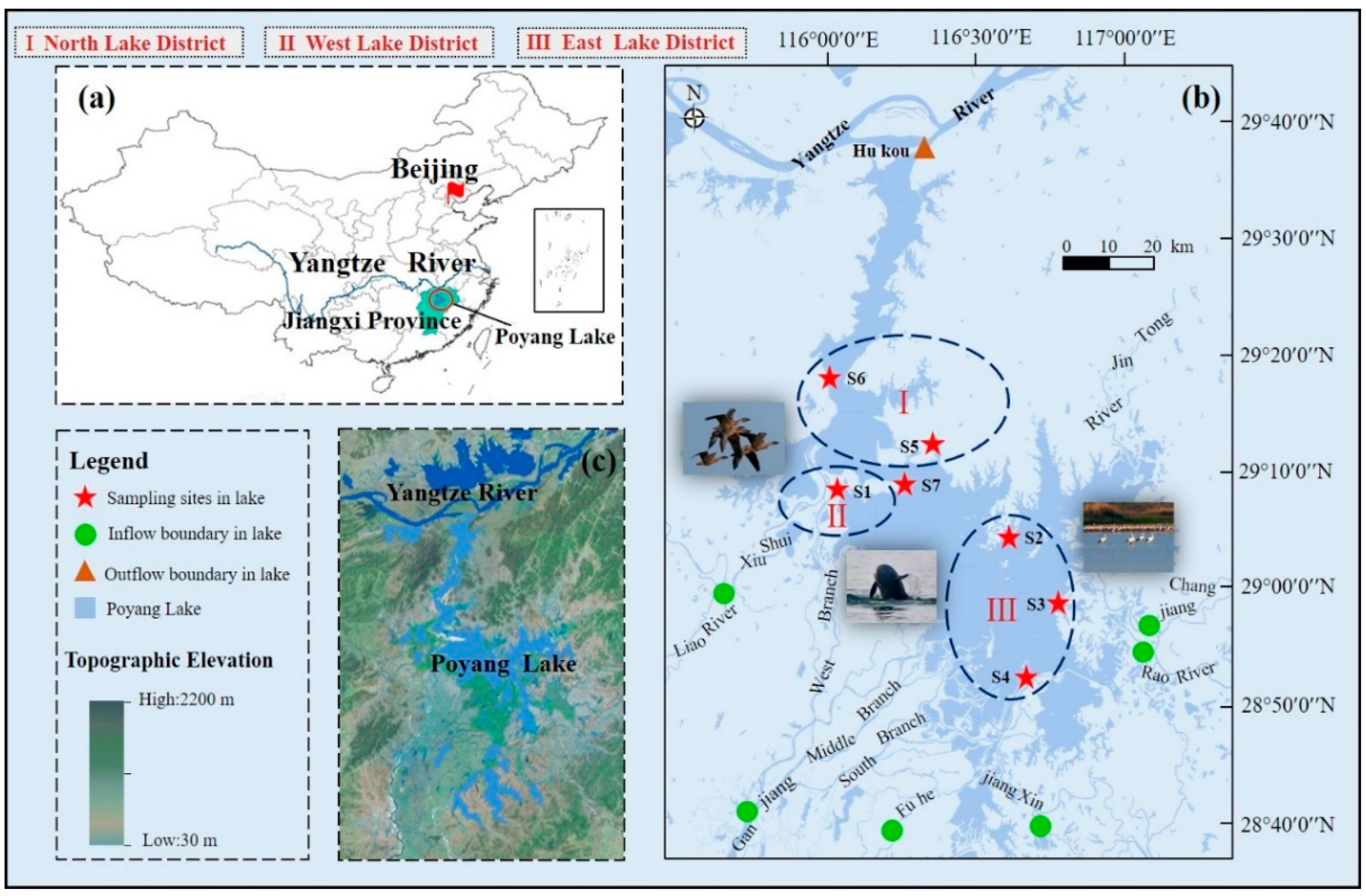

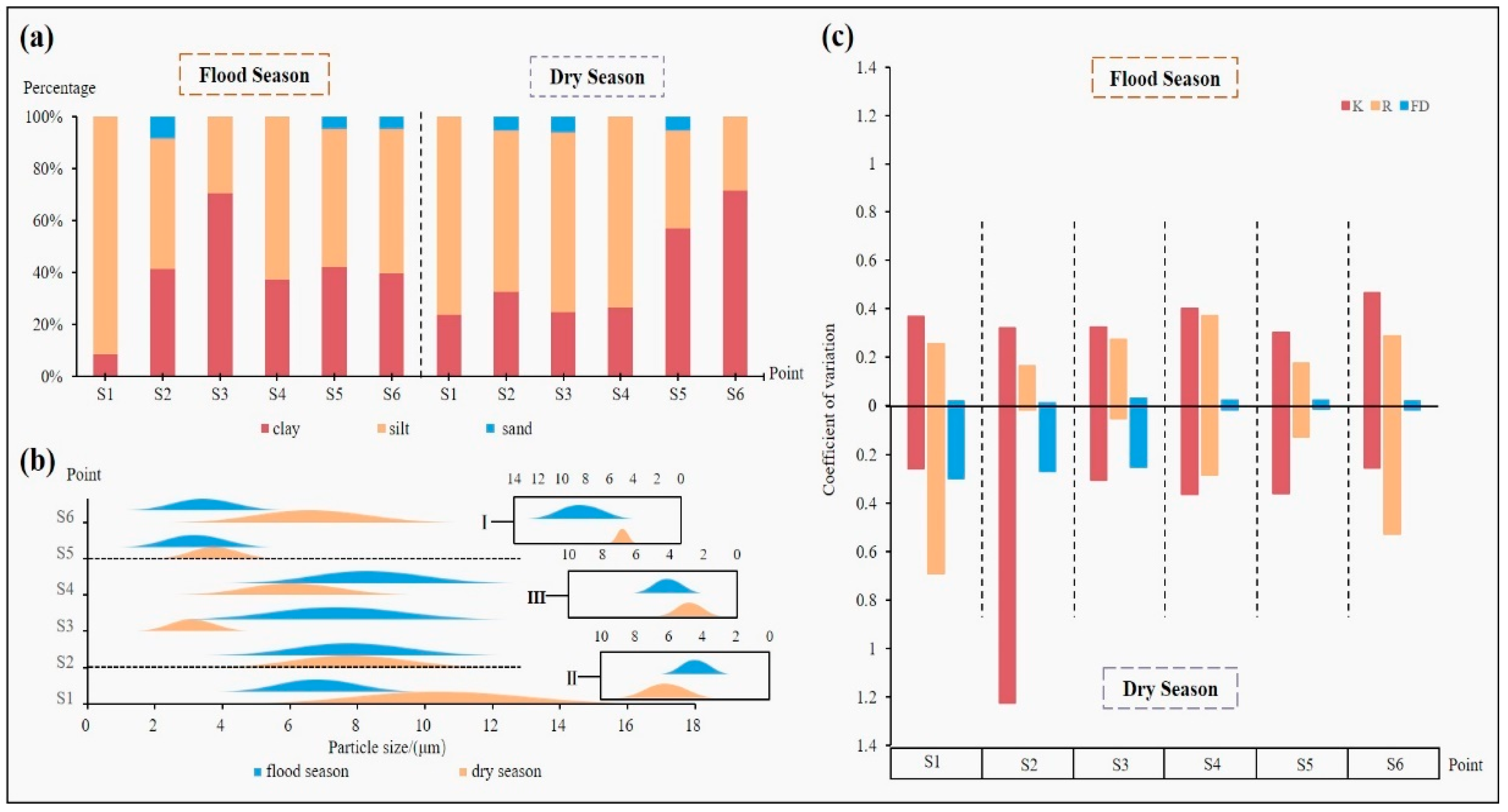
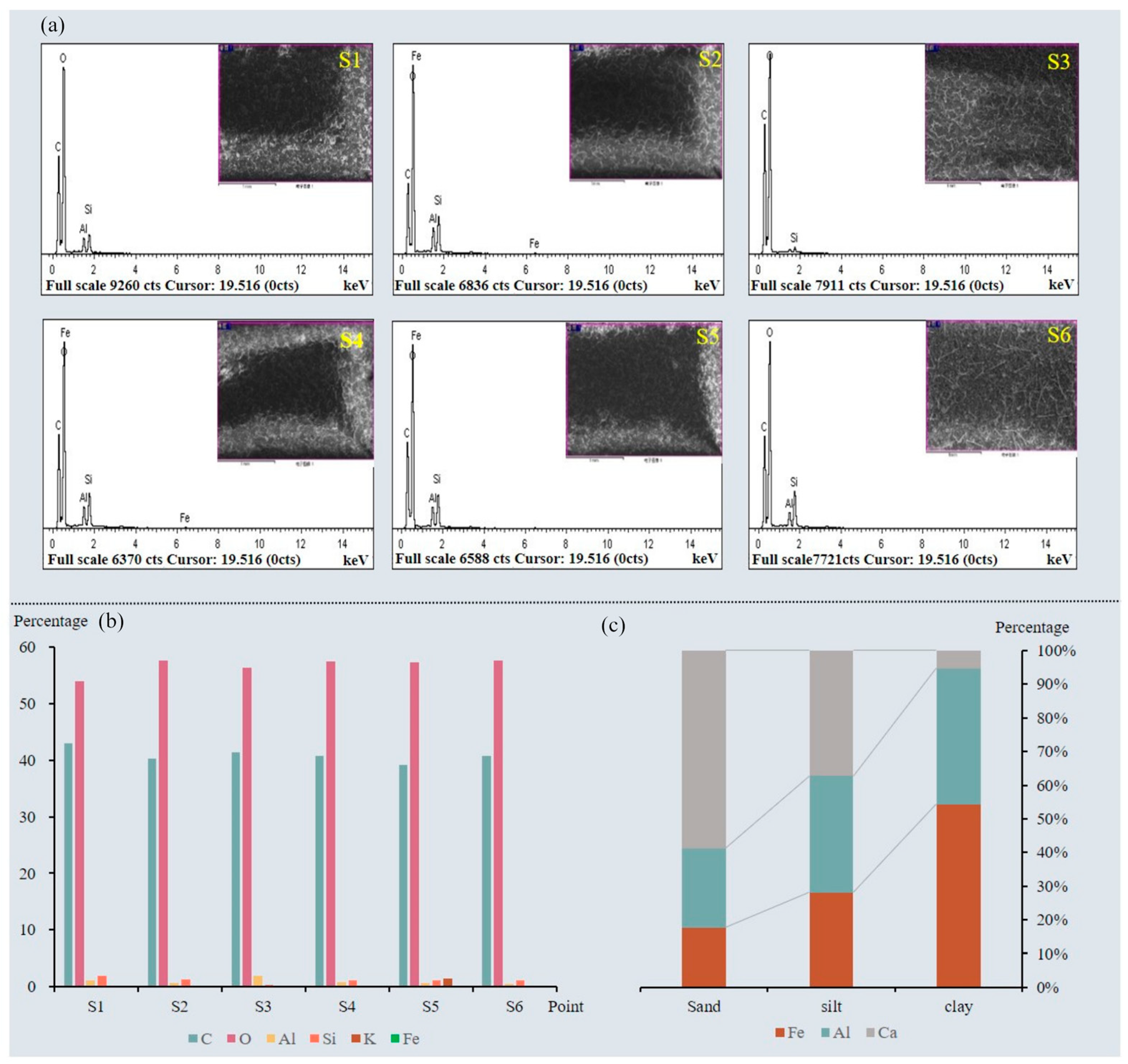
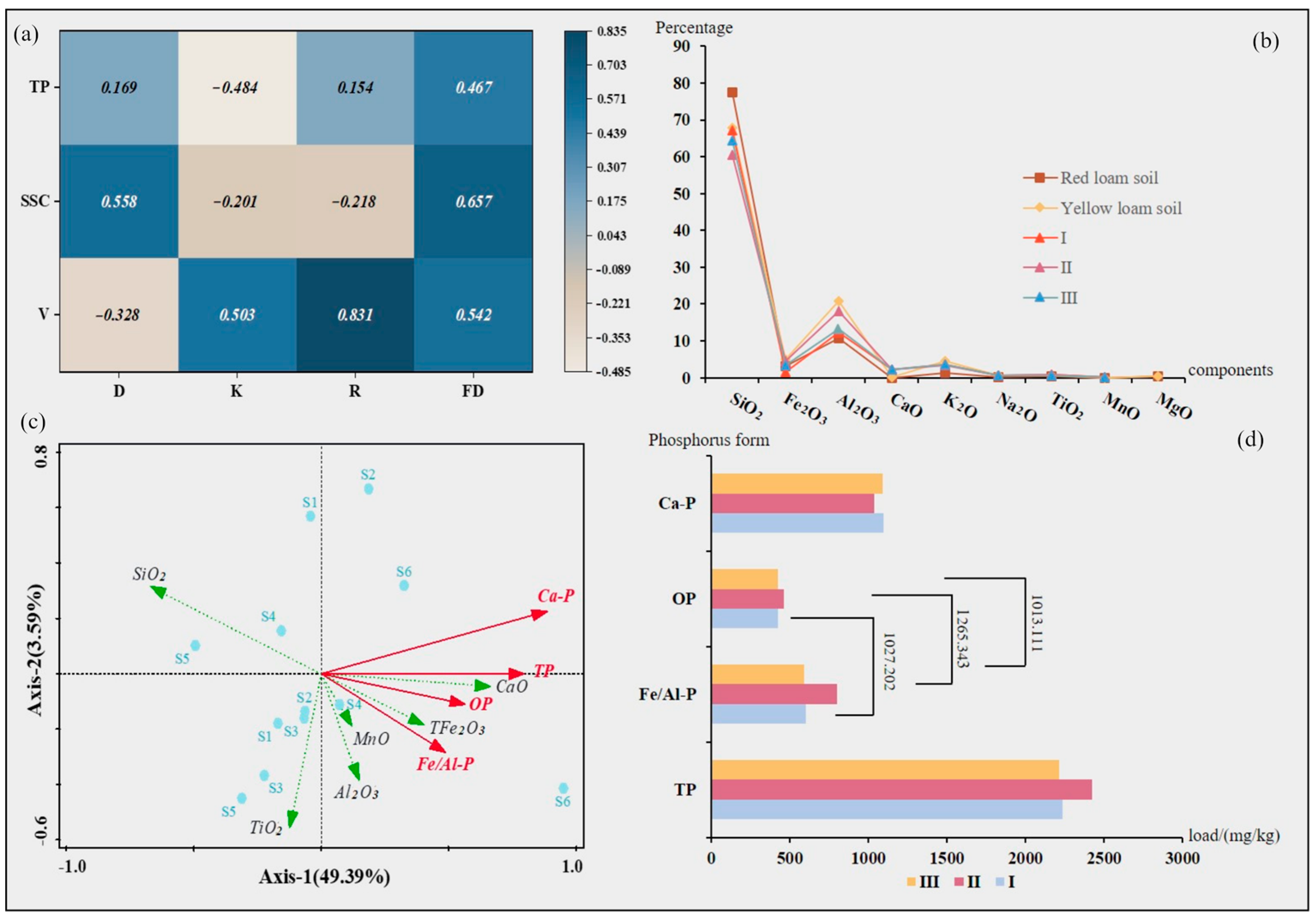
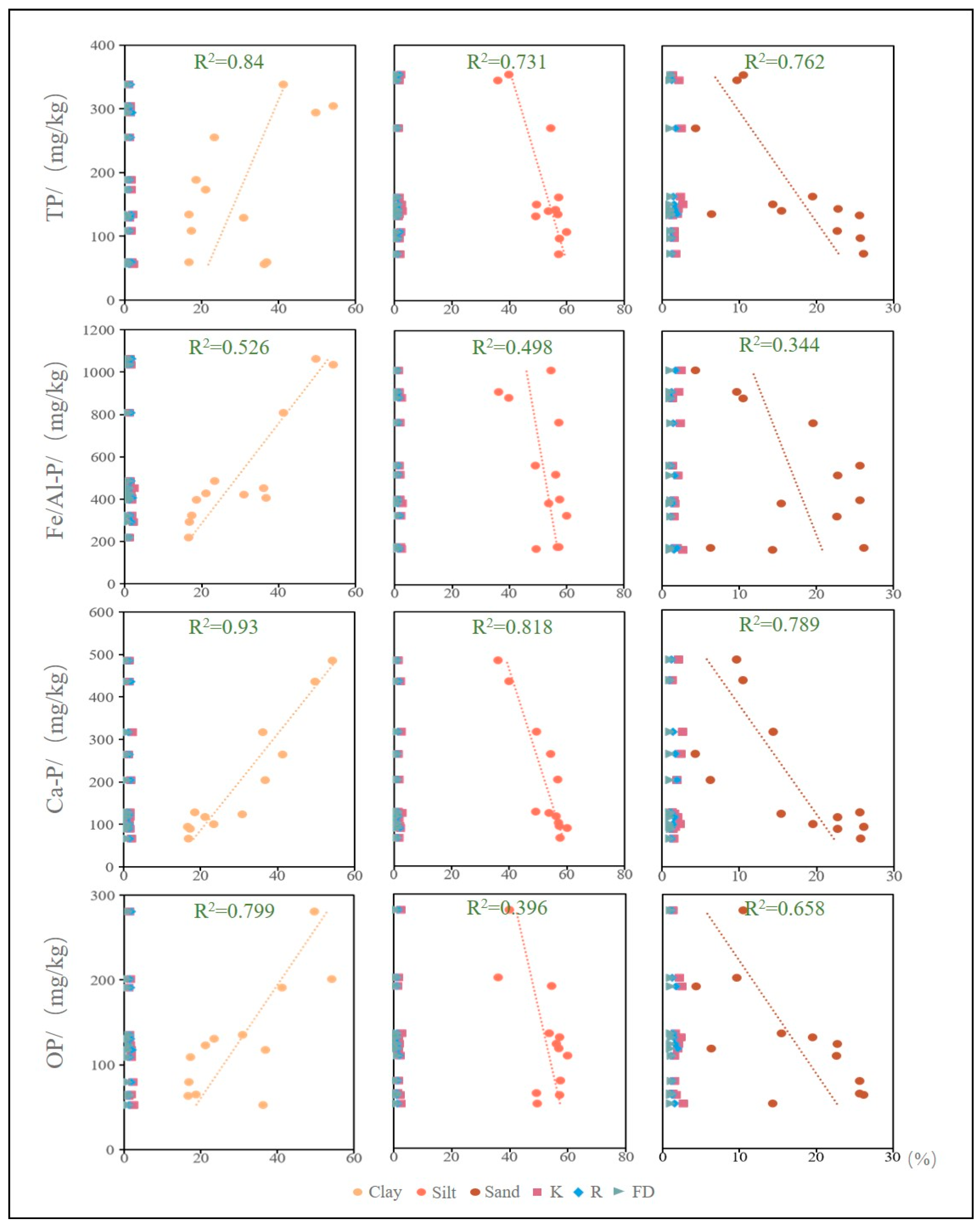
Disclaimer/Publisher’s Note: The statements, opinions and data contained in all publications are solely those of the individual author(s) and contributor(s) and not of MDPI and/or the editor(s). MDPI and/or the editor(s) disclaim responsibility for any injury to people or property resulting from any ideas, methods, instructions or products referred to in the content. |
© 2023 by the authors. Licensee MDPI, Basel, Switzerland. This article is an open access article distributed under the terms and conditions of the Creative Commons Attribution (CC BY) license (https://creativecommons.org/licenses/by/4.0/).
Share and Cite
Cui, F.; Wang, H.; Shen, Z.; Li, Y.; Li, S.; Tian, X. Physicochemical Properties and Environmental Effects of Suspended Sediment Particles in the Largest Freshwater Lake, China. Sustainability 2023, 15, 6888. https://doi.org/10.3390/su15086888
Cui F, Wang H, Shen Z, Li Y, Li S, Tian X. Physicochemical Properties and Environmental Effects of Suspended Sediment Particles in the Largest Freshwater Lake, China. Sustainability. 2023; 15(8):6888. https://doi.org/10.3390/su15086888
Chicago/Turabian StyleCui, Fang, Hua Wang, Zilin Shen, Yuanyuan Li, Siqiong Li, and Xueqi Tian. 2023. "Physicochemical Properties and Environmental Effects of Suspended Sediment Particles in the Largest Freshwater Lake, China" Sustainability 15, no. 8: 6888. https://doi.org/10.3390/su15086888




